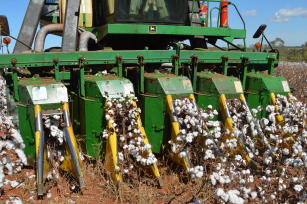Recomendações de boas práticas agrícolas para a destruição de restos culturais do algodoeiro
Recommendations of good agricultural practices for the destruction of cotton leftovers

Photo: SILVA, Sérgio Cobel da
The adequate destruction of crop leftovers aims to address the sanitary break, established by the legislation adopted by cotton producing states with the purpose of reducing pest populations (especially cotton weevil) and sources of inoculants of diseases (especially ramularia) during the crop off-season , reducing damage to the crop in the next harvest. This technological solution consists of the recommendation of combining mechanical destruction, using equipment developed exclusively for this purpose, with the chemical destruction of cotton crop leftovers, with the aim of eliminating the regrowth of both conventional cultivars and plants originating from materials with transgenics for resistance to the glyphosate herbicide. Currently, there is equipment that presents high operational capacity with minimal soil turning , which makes it possible to apply the technique in areas conducted under no-till farming. Mechanical destruction allows the elimination of most plants before the start of the sanitary break, ensuring a long period without food for pests and diseases. However, even with the high efficiency of destruction obtained, the efficiency of the equipment is never 100%, making it necessary to combine it with chemical destruction using the herbicide 2,4-D to control the plants remaining after mechanical destruction. The combination of the two destruction techniques ensures greater efficiency in the control of crop leftovers, eliminating pockets of multiplication of pests and diseases.
This technological solution was developed by Embrapa in partnership with other institution(s).
Where to find:
Destruição dos Restos Culturais do Algodoeiro (série Boletim P&D)
https://www.embrapa.br/algodao/busca-de-publicacoes/-/publicacao/1016743/destruicao-dos-restos-culturais-do-algodoeiro
Agricultural practice: For plant pest management Launch year: 2017
Country: Brazil Region: Central-West, Northeast, Southeast State: Distrito Federal, Goiás, Mato Grosso, Mato Grosso do Sul, Alagoas, Bahia, Ceará, Maranhão, Paraíba, Pernambuco, Piauí, Rio Grande do Norte, Sergipe, Roraima, Tocantins, Minas Gerais, São Paulo, Paraná Biome: Cerrado, Caatinga
Responsible Unit: Embrapa Cotton
